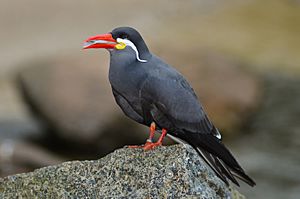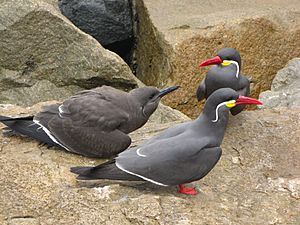Inca tern facts for kids
Quick facts for kids Inca tern |
|
|---|---|
 |
|
| An Inca tern at Walsrode Bird Park, Germany, enjoying a fish | |
| Conservation status | |
| Scientific classification | |
| Genus: |
Larosterna
|
| Species: |
inca
|
 |
|
The Inca tern (Larosterna inca) is a really cool bird that lives along the coast of South America. It's famous for its unique look, especially its long white "mustache" feathers! This bird is part of the gull and tern family. You can find it in countries like Chile, Ecuador, and Peru. Sometimes, it even flies as far as Central America or Hawaii. Sadly, it's considered a "Near Threatened" species, which means its numbers are getting low and it needs our help to survive.
Contents
About the Inca Tern's Family
The Inca tern is special because it's the only bird in its group, called Larosterna. It doesn't have any different types or subspecies.
What Does the Inca Tern Look Like?

The Inca tern is about 39 to 42 centimeters (15 to 17 inches) long. It weighs around 180 to 210 grams (6 to 7 ounces). That's about the weight of a small can of soda!
Adult Inca terns have a mostly dark gray body. Their throat and the feathers under their wings are a bit lighter. A cool white stripe starts near their beak and spreads out like long, silky feathers along their neck. The back edge of their wings and the tips of their outer wing feathers are white too. Their tail is black and has a moderate fork shape.
Their eyes are brown. Their legs and feet are a dark red color. Their beak is also dark red, with a patch of yellow skin at its base. Young Inca terns start off purplish-brown. They slowly change to brownish-gray before getting their adult feathers. Their beaks and legs are dark at first, then slowly turn red like the adults'.
Where Do Inca Terns Live?
The Inca tern lives in the area affected by the Humboldt Current. This is a cold ocean current along the west coast of South America. They breed from northern Peru down to a river in Chile called the Aconcagua River.
After breeding, some birds fly north into Ecuador. They are sometimes seen in Panama and Costa Rica. They have even been spotted far away in Guatemala and Hawaii. One bird spent many months exploring the islands of Hawaii!
Inca terns build their nests on sea cliffs and islands covered in guano (bird droppings). They also use man-made places like ledges under piers or old boats. They sometimes gather with other seabirds on sandy beaches.
How Do Inca Terns Behave?
Movement and Travel
Inca terns usually stay in the same area and don't migrate far. However, some do fly north after breeding season. A few individual birds have traveled very long distances!
What Do Inca Terns Eat?
Inca terns mostly eat small fish, like anchoveta. They also eat tiny ocean creatures called plankton. Sometimes, they eat scraps of food left by other animals.
You can often see huge groups of up to 5,000 Inca terns around fishing boats. They also follow cormorants, sea lions, whales, and dolphins when these animals are hunting. The terns catch their food mainly by diving headfirst into the water. They also pick up items from the surface while flying or floating.
Reproduction and Life Cycle
Inca terns don't seem to have a specific breeding season. Eggs have been found in different months throughout the year. They build their nests in many places. This includes cracks and caves in rocky cliffs. They also nest among rocks on island slopes. Sometimes, they use old burrows made by petrels or penguins. They even nest on or under human structures.
Usually, a female Inca tern lays two eggs, but sometimes only one. Both the male and female tern take turns sitting on the eggs to keep them warm. They also both bring food to their young. We don't know exactly how long the eggs take to hatch. But the young birds are ready to fly about four weeks after hatching. They still rely on their parents for food for at least a month after they can fly.
What Sounds Do Inca Terns Make?
Inca terns are loudest when they are at their nesting colonies. Their calls include loud, harsh cackling sounds. They also make a "mewing" sound. This mewing sound has been compared to the sound a kitten makes!
Why Is the Inca Tern "Near Threatened"?
The IUCN (International Union for Conservation of Nature) has said that the Inca tern is "Near Threatened." This means that while it's not in immediate danger, its population is getting smaller. We don't know exactly how many Inca terns there are, but it's believed to be decreasing.
During El Niño events (when ocean temperatures change), the terns have much less success raising their young. People catching too many of the small fish that Inca terns eat is also a problem. Climate change is another possible threat to these birds. In 2011, it was estimated that there were about 150,000 Inca terns.
See also
 In Spanish: Charrán inca para niños
In Spanish: Charrán inca para niños


